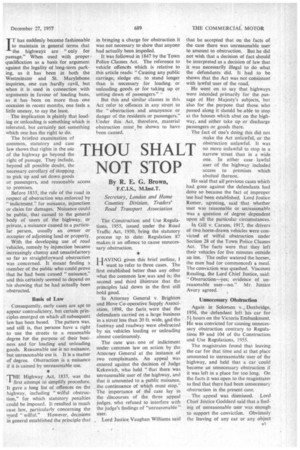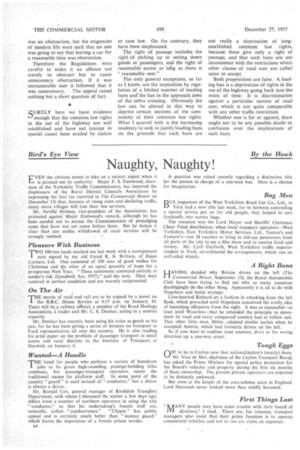THOU SHAL NOT STOP
Page 37

Page 38

If you've noticed an error in this article please click here to report it so we can fix it.
By R. E. G. Brown,
F.C.I.S., M.Inst.T, Secretary, London and Home Counties Division, Traders' Road Transport Association IT has suddenly become fashionable to maintain in general terms that the highways are "only for passage." When used with proper •
qualification as a basis for argument against the legality of long-term park ing, as it has been in both the Westminster and St. Maglebone inquiries, one can hardly cavil, but when it is used in connection with arguments in favour of loading bans, as it has been on more than one occasion in recent months, one feels a little uneasy, to say the least.
The implication is plainly that loading or unloading is something which is tolerated, but certainly not something which one has the right to do.
The briefest examination of common, statutory and case law shows that rights in the ute of the highway go beyond the right of passage. They include, beyond all possible doubt, the necessary corollary of stopping to pick up and set down goods or passengers, and reasonable access to premises.
Ref ore 1835, the rule of the road in respect of obstruction was enforced by " indictment " for nuisance, injunction or claim for damages. Nuisance could be public, that caused to the general body of users of. the highway, or private, a nuisance caused to a particular person, usually an owner or occupier of adjoining land or property.
With the developing use of road vehicles, remedy by injunction became increasingly clumsy and unsatisfactory so far as straightforward obstruction was ,concerned, It meant finding a • member of the public who could prove that he had been caused "nuisance," and this certainly seemed to depend on his showing that he had actually been obstructed.
Basis of Law
Consequently, early cases are apt to appear contradictory, but certain principles emerged on which all subsequent law has been based. The pattern was, and still is, that persons have a right to use the streets to a reasonable degree for the purpose of their business and for loading and unloading goods. Reasonable use is no nuisance, but unreasonable use is. It is a matter of degree. Obstruction is a nuisance if it is caused by unreasonable use.
JHE Highway Act, 1835. was the first attempt to simplify procedure. It gave a long list of offences on the highway, including " wilful obstruction," for which statutory penalties could be imposed. It resulted in much case law, particularly concerning the word "wilful." However, decisions in general established the principle that
in bringing a charge for obstruction it was not necessary to show that anyone had actually been impeded.
It was followed in 1847 by the Town Police Clauses Act. The reference to vehicle offences which is relative to this article reads: "Causing any public carriage, sledge etc. to stand longer than is necessary for loading or unloading goods or for -taking up or setting down of passengers."
But this and similar clauses in this Act refer to offences in any street to the "obstruction and annoyance or danger of the residents or passengers." Under this Act, therefore, material obstruction must be shown to have been caused.
The Construction and Use Regulations, 1955, issued under the Road Traffic Act, 1930, bring the statutory process up to date: Regulation 87 makes it an offence to cause unnecessary obstruction.
I4AVING given this brief outline, I " want to refer to three cases. The first established better than any other what the common law was and is; the second and third illustrate that the principles laid down in the first still hold good. ,
In Attorney General v. Brighton and Hove Co-operative Supply Association, 1898, the facts were that the defendants carried on a large business in a street less than 20 ft. wide, 4nd the footway and roadway were obstructed by six vehicles loading or unloading almost continuously.
The case wasone of indictment under common law on action by the Attorney General at the instance of two complainants. An appeal was entered against the decision of Judge Kekewieh, who held "that there was unreasonable user of the highway, and that it amounted to a public nuisance, the continuance of which must stop." The importance of then case lay in the discourses of the three appeal judges, who refused to interfere with the judge's findings of "unreasonable" user.
Lord Justice, Vaughan Williams said that he accepted that on the facts of the case there was unreasonable user to amount to obstruction. But he did not wish that a decision of fact should be interpreted as a decision of law that it was necessarily illegal to do what the defendants did. It had to be shown that the Act was not consistent with lawful user of the road.
He went on to say that highways were intended primarily for the passage of Her Majesty's subjects, but also for the purpose that those who passed along it should be able to stop at the houses which abut on the highway, and either take up or discharge passengers or goods there.
The fact of one's doing this did not make the Act unlawful, or the obstruction unlawful. It was no more unlawful to stop in a narrow street than in a wide one. In either case lawful user of the highway included access to premises which abutted thereon.
He said that all'previous cases which had gone against the defendants had done so because the fact of improper use had been established. Lord Justice Romer, agreeing, said that whether user was reasonable or unreasonable was a question of degree dependent upon all the particular circumstances.
In Gill v. Carson, 1917, the drivers of two horse-drawn vehicles were convicted of wilful obstruction under Section 28 of the Town Police Clauses Act. The facts were that they left their vehicles for five minutes outside an inn. The ostler watered the horses, the men had (or commenced) a meal. The conviction was quashed. Viscount Reading, the Lord Chief Justice, said: "Obstruction—yes; evidence of unreasonable user—no." Mr. Justice Avory agreed.
Unnecessary Obstruction
Again in Solomon v. Duxbridge, 1956, the defendant left his car for 51 hours on the Victoria Embankment. He was convicted for causing unnecessary obstruction contrary to Regulations 89 and 104 of the Construction and Use Regulations, 1955.
The magistrates found that leaving the car for that time and at that place amounted to unreasonable user of the highway, and held that a car could become an unnecessary obstruction if it was left in a place for too long. On the facts it was open to the magistrates to find that there had been unnecessarf obstruction in the present case.
The appeal was dismissed. Lord Chief Jtistice Goddard said that a finding of unreasonable user was enough to support thc conviction. Obviously the leaving of any car or any object was an obstruction, but the exigencies of modem life were such that no one was going to say that leaving a car for a reasonable time was obstruction.
Therefore the Regulations were careful to make it an offence not merely to obstruct but to cause unnecessary obstruction. If it was unreasonable user it followed that it was unnecessary. The appeal raised nothing but a short question of fact.
3URELY here we have evidence enough that the common law rights in the use of the highway are well established and have not (except in special cases) been eroded by statute
or case law. On the contrary, they have been emphasized.
The right of passage includes the right of picking up or setting down goods or passengers, and the right of reasonable access as Jag as there is "reasonable user."
The only general exceptions, so far as I know, are the imposition by regulation of a limited number of loading bans and the ban in the approach zone of the zebra crossing. Obviously the law can be altered in this way to deprive certain sections of the community of their common law rights. What I quarrel with is the increasing tendency to seek to justify loading bans on the grounds that such bans are
not really a deprivation of longestablished common law rights, because these give only a right of 'passage, and that such bans are not inconsistent with the restrictions which other classes of road user are called upon to accept.
Both propositions are false. A loading ban is a deprivation of rights in the use of the highway -going back into the mists of time. It is discrimination against a particular section of road user, which is not quite comparable with any other traffic restriction.
Whether one is for or against, there ought not to be any possible doubt or confusion over the implications of such bans.




















































































